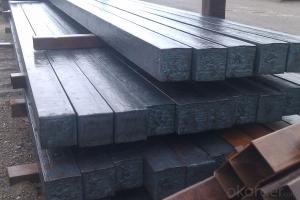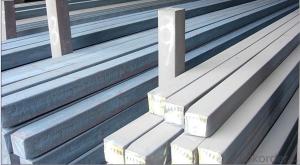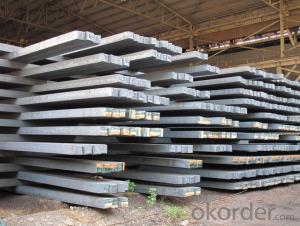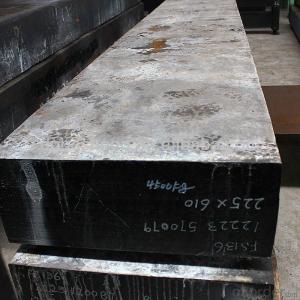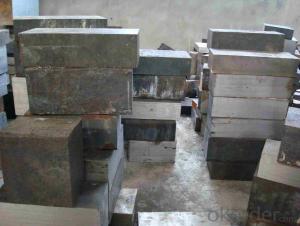Prime quality square alloy steel billet 135mm Q235
- Loading Port:
- Tianjin
- Payment Terms:
- TT OR LC
- Min Order Qty:
- 100 m.t.
- Supply Capability:
- 10000 m.t./month
OKorder Service Pledge
OKorder Financial Service
You Might Also Like
Structure of Prime quality square alloy steel billet 135mm Q235

Description of Prime quality square alloy steel billet 135mm Q235
1. Prepainted steel coil is coated with organic layer, which provides higher anti-corrosion property and a longer lifespan than that of galvanized or galvalume steel sheets.
2. The base metals for prepainted steel coil consist of cold rolled, HDGI Steel, electro-galvanized and hot-dip alu-zinc coated steel. The finish coats of prepainted steel coil can be classified into groups as follows: polyester, silicon modified polyesters, polyvinylidene fluoride, high-durability polyester, etc.
3. The production process has evolved from one-coating-and-one-baking to double-coating-and-double-baking, and even three-coating-and-three-baking.
4. The color of the prepainted steel coil has a very wide selection, like orange, cream-colored, dark sky blue, sea blue, bright red, brick red, ivory white, porcelain blue, etc.
5. The prepainted steel coils can also be classified into groups by their surface textures, namely regular prepainted sheets, embossed sheets and printed sheets.

Main Feature of Prime quality square alloy steel billet 135mm Q235
Uncoated CR steel sheet
With the features of in line with the international highest standards in demension and shape, excellent surface finish and properties, the products are mainly used in home appliance and automobile industries.
Galvanized steel sheet(include HDG and EG)
With the features of good corrosion resistance, the products are mainly used in automobile, home appliance, electronics, building and machinery manufacture industries, etc.
Precoated steel sheet
With the features of enviromental protection and good processablility, long lasting surface durability, rich in colors, the products are maily used in building, home appliance and furniture industries, etc.
Applications of Prime quality square alloy steel billet 135mm Q235
Construction
Manufacture anticorrosion, industrial and civil architecture roof boarding, roof grille
Light industries
Home appliance's case, civil chimney, kitchen utensils
Auto industry
Corrosion resistant parts of cars
Agriculture
Food storage, meat and aquatic products' freezing and processing equipment
Commerce
Equipments to store and transport materials, and packing implements

Specifications of Prime quality square alloy steel billet 135mm Q235
Product | Prime quality square alloy steel billet 135mm Q235 |
Material Grade | SGCC / SGCH / DX51D+AZ, etc |
Thickness | 0.6-3.0mm |
Width | 500-1500mm |
Tolerance | Thickness: +/-0.02mm , Width:+/-2mm |
Zinc-coating | Z30-150g/m2 |
Technique | Raw material: Hot rolled steel coil --> Cold rolled_>hot dipped galvalume |
Surface | Dried, Chromated, Unoiled |
Spangle | Regular spangle , small spangle, zero spangle |
ID | 508MM 610MM |
Coil weight | 1-25MT |
Export package | Cardboard inner sleeves, Waterproof paper, galvanized steel covered and steel strip packed |
FAQ of Prime quality square alloy steel billet 135mm Q235
We have organized several common questions for our clients,may help you sincerely:
1. How Can I Visit There?
Our company is located in Tianjin City, China, near Beijing. You can fly to Tianjin Airport Directly. All our clients, from home or aboard, are warmly welcome to visit us!
2. How Can I Get Some Sample?
We are honored to offer you sample.
3. Why choose CNBM?
Our delivery time about 15-20days for standard sizes, if you have other requirements like hardness, quanity and width ,it is about 20-40days. But don't worry we also try our best for the delivery time ,because time longer and our cost is higher.
- Q:What are the factors that affect the mechanical properties of steel billets?
- The mechanical properties of steel billets are influenced by several factors. These factors include the chemical composition, heat treatment, microstructure, grain size, processing conditions, surface condition, and environmental factors. 1. Chemical composition: The mechanical properties of steel billets are determined by the levels of carbon, manganese, silicon, and other alloying elements in the steel. These elements impact the strength, hardness, and ductility of the billets. 2. Heat treatment: By controlling the temperature and duration of heating and cooling, the mechanical properties of steel billets can be significantly altered. Techniques like annealing, quenching, and tempering can enhance the hardness, toughness, and overall strength of the steel. 3. Microstructure: The mechanical properties of steel are greatly influenced by its microstructure, which is determined by factors like cooling rate and alloying elements. Different phases, such as ferrite, pearlite, and martensite, affect the strength, ductility, and toughness of the billets. 4. Grain size: The size and distribution of grains in the steel billets have an impact on their mechanical properties. Finer grain sizes generally result in improved strength and toughness, while larger grain sizes may lead to reduced mechanical properties. 5. Processing conditions: The mechanical properties of steel billets are influenced by the processing conditions during production, such as temperature and rate of deformation. Techniques like rolling, forging, and extrusion affect the grain structure and overall mechanical behavior of the steel. 6. Surface condition: The mechanical properties of steel billets can be significantly affected by the surface condition, including the presence of defects like cracks, voids, or surface contamination. Surface defects act as stress concentration points and reduce the overall strength and integrity of the steel. 7. Environmental factors: The mechanical properties of steel billets can be influenced by environmental conditions like temperature, humidity, and exposure to corrosive substances. Corrosion can decrease strength and structural integrity, while high temperatures can cause softening or thermal degradation of the steel. Considering these factors is crucial in the design and manufacturing of steel billets to ensure that the desired mechanical properties are achieved for specific applications.
- Q:How do steel billets compare to other types of metal billets?
- Steel billets generally have several advantages over other types of metal billets. Firstly, steel is known for its strength and durability, making steel billets a reliable choice for various applications. Steel billets also have excellent heat and corrosion resistance, enhancing their longevity and performance. Additionally, steel billets offer a wide range of alloying possibilities, allowing for customization and the creation of specific properties for different applications. Overall, the superior strength, durability, and versatility of steel billets make them a preferred choice in many industries compared to other types of metal billets.
- Q:What are the main challenges in sourcing steel billets?
- There are several main challenges in sourcing steel billets. Firstly, one of the key challenges is ensuring a consistent and reliable supply of high-quality steel billets. Steel billets are typically sourced from steel mills or manufacturers, and it is crucial to find suppliers that can consistently meet the required specifications and standards. This involves conducting thorough research and due diligence to identify reputable and reliable suppliers who have a track record of producing high-quality billets. Another challenge is managing the cost and price fluctuations of steel billets. Steel prices are subject to various factors such as global demand, raw material costs, and market dynamics. As a result, the price of steel billets can be volatile, which can impact procurement decisions and budgets. Sourcing professionals need to carefully monitor market trends and negotiate pricing contracts to ensure the best value for their organization. Furthermore, logistics and transportation can pose challenges in sourcing steel billets. Steel billets are heavy and bulky, making transportation and logistics complex. Coordinating deliveries, managing shipping schedules, and ensuring timely arrival of the billets can be challenging, especially when sourcing from international suppliers. It is important to work closely with reliable logistics partners and have a robust supply chain management system in place to overcome these challenges. Quality control is another crucial aspect in sourcing steel billets. Due to the critical nature of steel in various industries, it is essential to ensure that the billets meet the required quality standards. This involves conducting quality inspections, reviewing certifications, and performing material testing to verify the integrity and properties of the billets. Regular audits and inspections should be conducted to maintain consistent quality throughout the sourcing process. Lastly, regulatory compliance and trade restrictions can present challenges in sourcing steel billets. Import/export regulations, tariffs, and trade barriers can impact the availability and cost of steel billets from certain regions. Sourcing professionals need to stay updated with the latest regulations and trade policies to navigate these challenges and ensure compliance with the applicable laws. In conclusion, the main challenges in sourcing steel billets include ensuring a consistent supply of high-quality billets, managing price fluctuations, handling logistics and transportation, maintaining quality control, and complying with regulatory requirements. Overcoming these challenges requires careful supplier selection, effective negotiation, robust supply chain management, and staying informed about market trends and regulations.
- Q:What do you mean by adding carbon to a table tennis racket?
- What a professional? I don't know what is known but with carbon carbon line take this hit the ball the more comfortable to take shape
- Q:What does "billet" mean?
- Steelmaking and continuous casting of steel products are mainly used for steel rolling, such as round bar, wire rod, sheet metal and so on
- Q:How are steel billets used in the production of oil and gas components?
- Steel billets are an essential component in the production of oil and gas components due to their strength, durability, and ability to withstand extreme conditions. These billets are used as raw materials in various manufacturing processes to create various equipment and parts required in the oil and gas industry. One common application of steel billets in oil and gas production is in the manufacturing of pipes and casings. These billets are heated and then rolled or forged into seamless or welded pipes, which are used for transporting oil and gas from wells to refineries or distribution centers. The high strength of steel billets ensures that these pipes can withstand the high pressure and corrosive nature of the substances being transported. Steel billets are also used in the production of valves, flanges, and fittings that are critical components in oil and gas infrastructure. These billets are machined or forged into various shapes and sizes to create these components, which are used to control the flow of oil and gas within the pipelines or at different stages of the production process. The durability and resistance to corrosion of steel billets make them ideal for these applications, as they can withstand the harsh conditions often encountered in oil and gas operations. Furthermore, steel billets are utilized in the production of drilling equipment such as drill bits, drill collars, and drill pipes. These billets are often treated with heat or alloying elements to enhance their strength and wear resistance. The resulting components are capable of withstanding the intense forces and abrasion encountered during drilling operations, ensuring efficient and reliable extraction of oil and gas reserves. Overall, steel billets play a vital role in the oil and gas industry by providing the necessary raw materials to manufacture durable and high-performance components. Their strength, durability, and resistance to corrosion make them an ideal choice for the challenging conditions encountered in the production, transportation, and processing of oil and gas.
- Q:How are steel billets used in the production of agricultural implements?
- Steel billets are used in the production of agricultural implements by being further processed and shaped into various components such as plowshares, tillage tools, and blades. These billets serve as the raw material from which these implements are manufactured, providing the necessary strength, durability, and resistance to withstand the demanding conditions of agricultural operations.
- Q:What are the different shapes of steel billets?
- Steel billets are available in various shapes and dimensions, which depend on their intended use and the method of production. The shapes commonly seen in steel billets include square, rectangular, round, and hexagonal. Square billets are mainly utilized in the construction industry for creating beams, columns, and other structural parts. Rectangular billets are also used in construction but are often preferred for applications that demand a specific width-to-height ratio, like window frames or door frames. Round billets are frequently employed in the manufacturing of pipes, tubes, and shafts due to their symmetrical shape and ability to withstand torsional forces. On the contrary, hexagonal billets are employed in industries such as automotive and aerospace, where their unique shape provides improved strength and stability. In summary, the selection of the shape of a steel billet is determined by the specific requirements of the final product and the manufacturing process employed.
- Q:How do steel billets contribute to the manufacturing of construction machinery?
- The manufacturing of construction machinery heavily relies on steel billets. These cylindrical or square bars of steel serve as the primary raw material for producing a wide range of components and parts used in construction machinery. Firstly, steel billets play a crucial role in creating the structural frame of construction machinery. The high strength and durability of steel make it an ideal material for guaranteeing the structural integrity of heavy machinery. By shaping and welding steel billets together, a sturdy frame is formed, providing the necessary support and stability to the equipment. Furthermore, steel billets are utilized in the manufacturing of critical components like gears, shafts, and axles. These components require high tensile strength and resistance to wear and tear, qualities that can be achieved using steel billets. By machining, forging, or casting steel billets into the desired shape, these components become capable of withstanding the heavy loads and harsh operating conditions present in the construction industry. Moreover, steel billets are essential in the production of buckets, blades, and cutting edges for construction machinery. These components face extreme forces and abrasion during excavation, grading, and other construction activities. The excellent hardness and toughness of steel billets ensure that these components can withstand such demanding conditions and perform effectively. Additionally, steel billets are necessary for the production of hydraulic cylinders and pistons. These components are responsible for generating the force needed to lift, push, and pull heavy loads in construction machinery. Through machining and shaping steel billets, cylinder bodies and pistons are created, guaranteeing the required strength and precision for efficient hydraulic operations. In conclusion, steel billets are indispensable in the manufacturing of construction machinery. They provide the necessary strength, durability, and wear resistance for the various components and parts used in construction equipment. By utilizing steel billets, construction machinery can withstand the demanding conditions and heavy workloads encountered in the construction industry, contributing to their overall performance and reliability.
- Q:How are steel billets inspected for surface defects?
- To ensure the quality and integrity of steel billets, a variety of methods and techniques are employed to inspect them for surface defects. One way is through visual inspection, where trained inspectors carefully scrutinize the billets for any visible flaws such as cracks, scratches, pits, or unevenness. They utilize appropriate lighting and magnification tools to conduct a thorough examination of the entire surface. Another method in use is dye penetrant testing. This involves applying a liquid dye to the billet's surface, allowing it to seep into any cracks or defects. After a designated period, excess dye is removed and a developer is added. The developer brings out the dye from any defects, making them clearly visible and easily identifiable. Magnetic particle inspection is another widely utilized technique. During this process, the billets are magnetized, and iron particles are applied to the surface. Any surface flaws disrupt the magnetic field, causing the iron particles to gather around the defect, thus making them easily detectable upon inspection. This method proves particularly effective for identifying defects such as surface cracks. Ultrasonic testing is also commonly employed to inspect steel billets. It entails transmitting high-frequency sound waves through the material, which then produce reflections or echoes when encountering any surface defects or internal flaws. These reflections are detected and analyzed, providing valuable information about the defect's size, location, and type. Furthermore, eddy current testing can be utilized to inspect steel billets for surface defects. This method involves passing an alternating current through a probe positioned near the billet's surface. Any defects or variations in the material's conductivity cause changes in the eddy currents, which can be detected and analyzed to identify surface defects. In conclusion, steel billets undergo meticulous inspection utilizing a combination of visual, dye penetrant, magnetic particle, ultrasonic, and eddy current testing methods. This ensures that any surface defects are promptly identified and addressed, thereby guaranteeing the quality and reliability of the final product.
1. Manufacturer Overview |
|
|---|---|
| Location | |
| Year Established | |
| Annual Output Value | |
| Main Markets | |
| Company Certifications | |
2. Manufacturer Certificates |
|
|---|---|
| a) Certification Name | |
| Range | |
| Reference | |
| Validity Period | |
3. Manufacturer Capability |
|
|---|---|
| a)Trade Capacity | |
| Nearest Port | |
| Export Percentage | |
| No.of Employees in Trade Department | |
| Language Spoken: | |
| b)Factory Information | |
| Factory Size: | |
| No. of Production Lines | |
| Contract Manufacturing | |
| Product Price Range | |
Send your message to us
Prime quality square alloy steel billet 135mm Q235
- Loading Port:
- Tianjin
- Payment Terms:
- TT OR LC
- Min Order Qty:
- 100 m.t.
- Supply Capability:
- 10000 m.t./month
OKorder Service Pledge
OKorder Financial Service
Similar products
New products
Hot products
Related keywords
